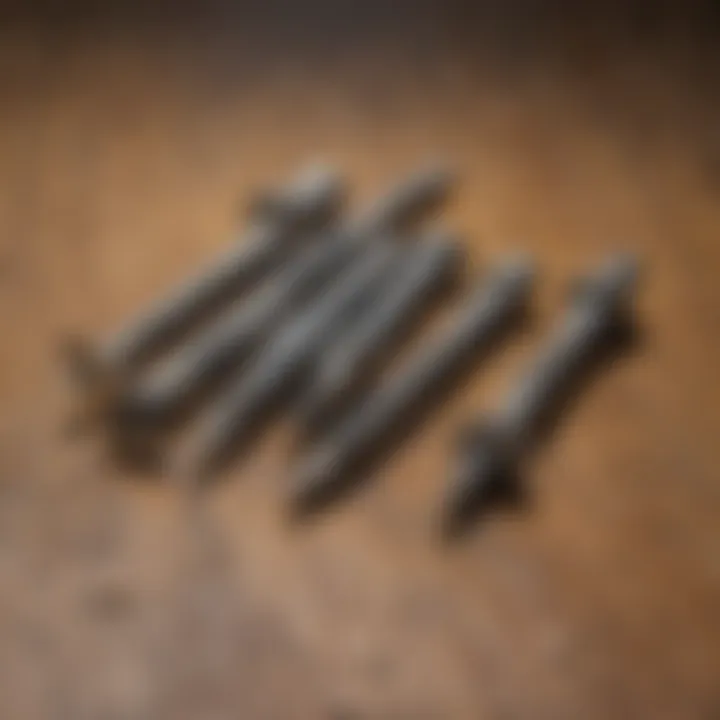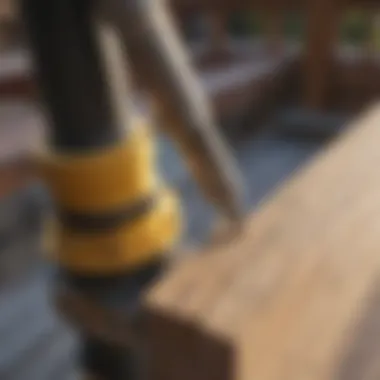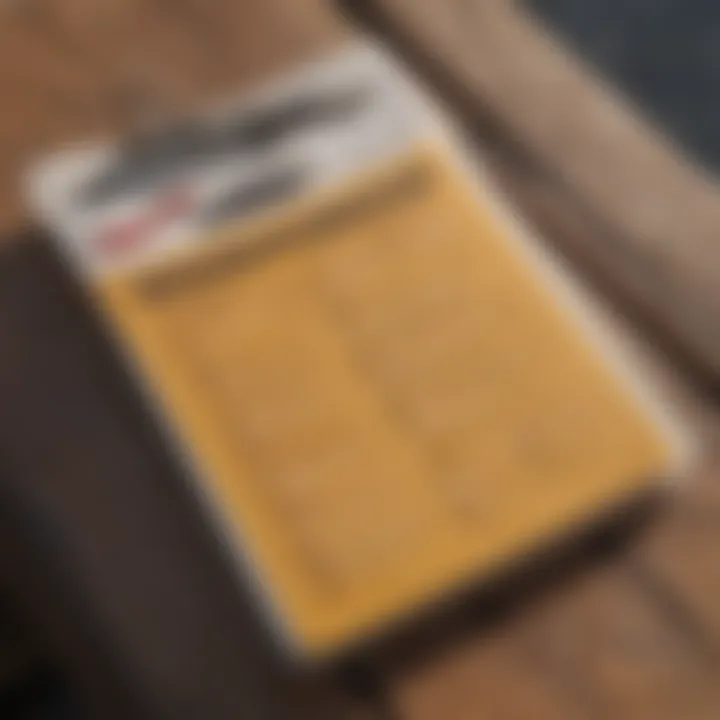The Ultimate Guide to Choosing Exterior Deck Screws


Intro
Exterior deck screws play a crucial role in the construction and maintenance of outdoor structures like decks and patios. These fasteners are specifically designed to endure various weather conditions while providing strength and durability. Their role in ensuring the integrity of a deck cannot be overstated. Without high-quality screws and proper installation, even the best-designed deck can quickly deteriorate, leading to costly repairs or unsafe conditions.
Understanding exterior deck screws is essential for homeowners looking to work on their outdoor projects. These screws differ significantly from interior ones, primarily due to their materials and protective coatings that resist rust and corrosion. Homeowners should recognize the importance of selecting the right type of screw, as it can impact both the longevity and safety of their deck.
The right exterior deck screw can extend the life of any decking project and ultimately enhance the overall appearance and functionality. In this guide, we cover various aspects crucial for making informed decisions on exterior deck screws, including common challenges faced during installation, actionable solutions, top product recommendations, and practical step-by-step guides for successful installation.
Good decisions start with good knowledge. This guide aims to ensure every homeowner has the necessary information to tackle their projects effectively.
Understanding Exterior Deck Screws
Understanding exterior deck screws is essential for anyone involved in building or renovating outdoor spaces. These screws are often the unsung heroes of construction, quietly holding structures together while enduring the elements. Hence, knowing their intricacies can lead to better project outcomes and longer-lasting results.
When it comes to the importance of exterior deck screws, several key elements and benefits come into play. First, the right screws ensure stability and safety in deck structures, fending off issues like wobbling or loosening over time. Second, selecting high-quality materials protects against rust and corrosion, especially when paired with varying weather conditions. This knowledge is vital, as outdoor installations are subject to moisture, temperature shifts, and other environmental stressors.
Moreover, different types of deck screws cater to specific applications. For instance, screws designed for wood differ significantly from those meant for composite materials or concrete. The consideration of which type to use can dictate the success of the entire project. Therefore, recognizing these distinctions helps avoid limited durability and potential future repairs.
As one delves into the finer details of deck screws, understanding their composition, size, and application techniques will empower homeowners and builders alike. Informed decisions in this area will lead to enhanced results and overall satisfaction in the finished product. This guide aims to bridge the knowledge gap, providing clarity and assurance in the often overlooked aspect of exterior construction.
Definition and Purpose
Exterior deck screws are specially designed fasteners used to join various materials in outdoor construction applications. They provide the necessary holding power for decks, fences, and other structures exposed to differing weather conditions. The purpose of these screws extends beyond fastening; they serve to maintain the integrity of outdoor spaces while accounting for expansion and contraction due to temperature and weather changes.
In essence, their design often includes features that enhance grip and minimize risks such as stripping or galling. Most exterior deck screws have a corrosion-resistant coating or are made from specific metal types, which play a crucial role in their performance.
Historical Context
The history of deck screws dates back to the early days of construction, where builders relied on iron and wood for outdoor structures. These fasteners were fundamental in improving the durability of decks and similar constructions. Over the years, advancements in materials science led to the development of stainless steel and coated options, enhancing performance in outdoor settings.
Once traditional decking materials became common, the screws evolved alongside them, adapting to offer better performance in relation to variety of outdoor materials. As more homeowners began to enhance their outdoor living spaces, the demand for reliable and high-performance deck screws continued to grow, shaping the current offerings in the marketplace.
Material Composition of Deck Screws
Understanding the material composition of deck screws is crucial for their selection and application. Different materials offer various advantages and disadvantages that can significantly influence the durability and performance of your construction projects. The right choice ensures longevity and safety, making it an essential point of consideration for homeowners and builders alike. Here, we explore three primary materials used in deck screw manufacturing: stainless steel, coated steel, and bronze. Each material presents unique properties that cater to specific needs and environmental conditions.
Stainless Steel
Stainless steel is a popular choice for exterior deck screws due to its impressive resistance to rust and corrosion. This makes it especially suitable for coastal areas or regions with high humidity. The alloy typically contains chromium, which forms a protective layer that enhances durability. When selecting stainless steel screws, it is important to opt for grade 304 or 316.
- Grade 304: Excellent for general use, but can corrode in saline environments.
- Grade 316: Provides superior corrosion resistance, making it ideal for marine applications.
In addition to corrosion resistance, stainless steel screws maintain their strength over time. This means they are less likely to fail under stress. Importantly, they also match well with many decking materials, minimizing the risk of discoloration. However, the cost of stainless steel screws can be higher than other options, which is a trade-off to consider for your project.
Coated Steel
Coated steel screws, often finished with a layer of epoxy or polymer, provide a balance between performance and cost. The coating significantly enhances their resistance to corrosion, making them suitable for various outdoor projects. However, the durability of the coating can vary. Not all coatings are created equal, and some may wear down over time, exposing the underlying steel.
- Pros: Cost-effective, good initial corrosion resistance, various colors available.
- Cons: Coatings can degrade, resulting in potential corrosion; not suitable for extreme weather conditions.
When opting for coated steel screws, it is sensible to check the manufacturer's specifications regarding their performance in outdoor settings. Factors like lifespan, environment, and expected load should guide the decision.
Bronze
Bronze screws traditionally represent a higher-end option primarily because of their corrosion resistance and aesthetic appeal. Their composition typically includes copper, which offers excellent durability against harsh weather conditions.
For those building decks in humid coastal areas, bronze screws can be a reliable option. They resist rust and corrosion effectively, which means they can endure without sustaining significant damage.
- Pros: Exceptional corrosion resistance, natural beauty that complements wood.
- Cons: Higher cost, heavier weight compared to other screw materials.
Bronze screws may also be significant in historical restoration or where aesthetics are valued. The ability of bronze to blend with wood creates an appealing finish for decking projects.
Types of Exterior Deck Screws
Understanding the various types of exterior deck screws is crucial for any construction or repair project involving outdoor spaces. Each type serves a particular purpose and comes with unique properties that can significantly affect the performance and longevity of a deck installation. By choosing the right type of screw, users can ensure better durability, enhanced aesthetics, and optimal functionality.
Wood Deck Screws
Wood deck screws are specifically designed for use with wood materials, making them a popular choice for traditional decking projects. These screws often have a sharp point and aggressive threading that enables easy penetration into wood fibers. One of the main benefits of wood deck screws is their ability to grip the wood tightly, thereby reducing the risk of loosening over time.
Additionally, many wood deck screws are treated with a protective coating to resist corrosion, which is particularly important for outdoor applications where exposure to moisture is common. For instance, screws marketed under brands such as Deckmaster are known for their quality and longevity in various climates.
Wood deck screws generally come in various lengths and diameters, accommodating different thicknesses of wood. Selecting the appropriate size is essential for achieving the desired strength and integrity in the deck structure. An average recommendation is to use screws that penetrate the wood by at least 1.5 times the thickness of the material being fastened.
Composite Deck Screws
Composite deck screws are tailored for use with composite decking materials, which have become increasingly popular due to their resistance to rot and fading. These screws are essential for ensuring a secure hold without damaging the composite surface. Unlike wood screws, composite deck screws often have a specially designed head that prevents the screw from tearing the material.
The material used in these screws often contains a blend of metals and polymers, providing enhanced protection against corrosion and wear. Many homeowners prefer high-quality brands such as Starborn because of their tailored design, which includes features like self-tapping points to simplify installation.
Using composite deck screws takes away the worry about splitting or cracking the decking material, which can occur with other types of fasteners. This type is crucial for maintaining the visual appeal and structural durability of the deck over time.
Concrete Screws
Concrete screws are designed for fastening through wooden decking into concrete structures or foundations. They excel in providing strong anchorage, ensuring that the deck is securely attached to an underlying concrete slab. This type of screw typically requires a pre-drilled hole in the concrete, allowing for a snug fit and optimal strength.
Brands like Tapcon are well-regarded in the field, offering a range of products that help secure decks in various environmental conditions. These screws are usually coated with materials that enhance their resistance to moisture and chemicals often found in outdoor settings.


Beneath their surface simplicity, concrete screws require careful attention to detail in terms of installation, as misalignment or improper drilling can lead to failures in securing the deck. For best results, it is advisable to adhere to the manufacturer's specific guidelines regarding hole sizes and installation depth.
In summary, the choice of deck screws should align with the deck material and desired application. Each type of screw brings distinct advantages that can contribute to the overall success and longevity of your outdoor projects.
Size and Length Considerations
When selecting exterior deck screws, understanding the proper size and length is crucial. This choice has direct implications for the strength, durability, and overall performance of your deck. Using screws that are not correctly sized can lead to various issues, including structural weakness, easy stripping, and poor weather resistance.
The size of a screw typically refers to its diameter, while the length pertains to how far the screw penetrates the material. Choosing appropriate sizes ensures that the screws hold materials securely and resist the forces they encounter over time, like weight and movement.
The following are two important aspects to consider in depth: standard sizes and length selection guidelines.
Standard Sizes
Deck screws come in several standard sizes, usually measured by their diameter and length. Common diameters range from #8 to #12, with lengths varying significantly based on the project's demands. For instance, the #8 size is often sufficient for lighter applications, while thicker #10 or #12 screws are recommended for heavier installations.
- #8 screws are commonly used for boards up to 1 inch thick.
- #10 screws offer increased holding power and are suitable for thicker materials or structural components.
- #12 screws are ideal for heavy-duty tasks where significant load-bearing capacity is required.
Choosing the right diameter and length helps maintain the integrity of the deck.
Length Selection Guidelines
Length selection is equally important as diameter. Generally, the length of the screw should be approximately twice the thickness of the material being fastened. For example, if you are fastening two wooden planks that are each 1 inch thick, a 2-inch screw would provide adequate penetration without risking the screw from breaking or stripping.
When selecting the proper length, consider:
- Material Type: Different materials may require different lengths for optimal grip. For instance, composite decking often demands longer screws compared to traditional wood.
- Actual Conditions: Factors such as moisture or expansion can impact screw longevity. Longer screws may be more secure in unstable conditions.
- Manufacturer Recommendations: Always refer back to the guidance offered by screw manufacturers. They may provide specific length guidelines based on the materials being used.
Always ensure that the selected screws penetrate enough to create strong connections while allowing for natural material movement.
Ultimately, by paying attention to both size and length, you can enhance the performance of your deck screws. This attention to detail contributes to the longevity of your outdoor projects, allowing you to enjoy a stable and safe deck for years ahead.
Screw Head Types and Their Functions
Understanding the types of screw heads is crucial because they directly influence both the functionality and aesthetics of deck installations. Different head types address specific tasks, offering advantages that can enhance the performance of deck screws in various applications. The right screw head ensures that tools can be properly engaged, which contributes to ease of installation and long-term durability. When selecting screws, consider the head type as a vital element that can either streamline the installation process or complicate it.
Flat Head Screws
Flat head screws are among the most common types used in deck construction. Their design allows them to sit flush with the surface of the material, providing a smooth finish. This is particularly important for wooden decks, where a clean appearance is desired. The wide bearing surface helps to distribute the load evenly, reducing the risk of splitting the wood.
Flat head screws are often used with countersinking, which creates a conical hole that lets the head sit below the surface. This feature is advantageous for aesthetic purposes and minimizes any potential snags or catches when walking across the deck. Homeowners often prefer them for visible areas where aesthetics align with functionality.
Countersunk Screws
Countersunk screws are designed to be installed at an angle, allowing the screw head to sink into the material. This allows for a flat surface that minimizes the risk of injury and enhances the look of the deck. Additionally, countersunk screws create a tight fit, reducing movement and potential wear over time.
They are extremely beneficial when working with softwoods because the countersinking helps to prevent splitting. During installation, using a dedicated countersink bit can ease the process and achieve the correct depth, guaranteeing that the heads are not only properly placed but also aesthetically pleasing. Homeowners keen on having a neat, polished deck might find countersunk screws to be the best option.
Pan Head Screws
Pan head screws have a rounded top and a slightly flat underside that provides a larger contact area. This design allows for better load distribution and can be particularly useful in applications involving composite decking materials. Unlike flat heads, pan head screws remain slightly elevated above the surface, making them easier to grip with a screwdriver.
Their robust shape is beneficial for projects that demand a more secure fastening, such as in areas where the deck encounters significant foot traffic. Notably, for those who prioritize ease of installation, pan head screws can be a practical choice. They are less conducive to stripping than flatter counterparts, providing an increased level of confidence during installation.
"Choosing the right screw head type is essential for maximizing the performance of your deck. It often determines both the ease of installation and the durability of the deck over time."
In summary, understanding screw head types and their functions can empower homeowners and builders to make informed choices during deck construction. Each type serves a purpose, and selecting the right one aligns with both functionality and design preferences.
Factors Influencing Screw Performance
Understanding the various factors that influence screw performance is vital for ensuring structural integrity, longevity, and overall satisfaction in your deck projects. Selecting the right exterior deck screw requires careful consideration of multiple elements, including corrosion resistance, load-bearing capacity, and how the screw reacts to environmental changes like temperature and moisture. Each factor plays a pivotal role in determining the efficacy of the screws you choose, impacting not only the durability of the deck itself but also the safety of those who use it.
Corrosion Resistance
Corrosion is a significant concern for exterior deck screws as they are constantly exposed to moisture, fluctuating temperatures, and even chemicals from treatments used on wood. To ensure long-lasting performance, the choice of material is crucial. For example, stainless steel screws offer excellent resistance to rust and corrosion, making them a top choice for wet environments. On the other hand, coated steel screws, while less expensive, may not provide the same level of durability over time if the coating becomes compromised.
It's important to recognize that not all outdoor environments are the same. Areas with high humidity or proximity to saltwater, such as coastal regions, will require even more robust solutions. Regular maintenance can also play a role, as a proactive approach can combat some forms of corrosion before they become damaging. A well-maintained deck can greatly extend the lifespan of the screws used within it.
"Choosing the right material for your screws can save you significant costs on repairs in the future."
Load-Bearing Capacity
The load-bearing capacity of screws is a critical factor that cannot be overlooked. When constructing a deck, the structure must support various weights, including furniture, foot traffic, and environmental loads like snow or rainwater. Each screw has a specified load limit, and it’s essential to ensure that the screws used can handle the expected weight.
Improper selection can lead to failure, which not only risks the integrity of the deck but also poses safety hazards. When selecting screws, consider the diameter and length, as these dimensions will impact load-bearing capabilities. Consulting manufacturer specifications can help find appropriate screws for your specific load requirements. For example, you might find that a thicker screw is necessary for heavier loads, whereas lighter constructs, like composite decking, can often suffice with smaller screws.
Expansion and Contraction
Environmental factors affect how materials expand and contract, and this includes the screws used in decking. As temperatures rise and fall, materials will experience changes in size. Screws may loosen or become embedded deeper due to these fluctuations, potentially leading to structural issues over time.
To mitigate the braking point of expansion and contraction, using screws with specific designs may help. Some screws are engineered to allow for slight movement without compromising the tightness needed for stability. It’s also advisable to account for seasonal conditions in planning the placement and type of screws. By doing so, you enhance the overall durability of the deck and minimize the need for frequent repairs.
In summary, a careful assessment of these factors will lead to better performance of your screw selection, enhancing the longevity and safety of your deck.
Installation Techniques for Exterior Deck Screws
When it comes to constructing durable outdoor decks, the techniques used for installing exterior deck screws are of paramount importance. Proper installation ensures that the screws function effectively, securing the deck to its supports and enhancing its overall longevity. Various techniques can mitigate common issues brought on by environmental factors and materials used in deck construction. Therefore, understanding the following practices can make a considerable difference in the performance of deck construction.
Pre-Drilling


Pre-drilling is a technique that involves creating a pilot hole in the material before inserting a screw. This method is particularly useful when working with hardwoods or composite materials that can easily split, especially near their edges. By drilling a pilot hole, you are reducing the chances of splitting and ensuring a more secure connection.
The diameter of the pilot hole is important. Generally, it should be slightly smaller than the diameter of the screw shaft. This ensures that the screw can grip the material while allowing enough space for it to enter without excessive force.
Benefits of pre-drilling include:
- Minimized Splitting: Reduces the likelihood of splintering the wood.
- Accurate Placement: Helps achieve better alignment, especially when the screw needs to be placed precisely.
- Easier Driving: Allows for smoother insertion, which is crucial in tougher materials.
Follow these steps for effective pre-drilling:
- Select the appropriate drill bit based on your screw size.
- Measure and mark where the screw will be placed.
- Drill to the correct depth to match the screw length.
This preparation is worth the time, enhancing your construction's quality.
Using the Right Driver
Utilizing the correct driver is essential for the successful installation of exterior deck screws. A driver refers to the tool that turns the screw into the material. There are various types of drivers, including manual screwdrivers and power drills. However, the significant consideration is the type and size of the driver bit.
Screw heads come in different designs that require specific bits, such as Phillips, flat, and Torx. Choosing the right bit not only improves the ease of installation but also helps prevent stripping the screw head.
Consider the following factors:
- Bit Size: Match the bit size to the screw head for better control and torque.
- Driver Type: A power drill can speed up the process but requires careful handling to avoid overdriving.
- Torque Control: If using a power driver, ensure it has adjustable torque settings to prevent damage to the screw or material.
To summarize, both pre-drilling and using the correct driver are critical aspects of installing exterior deck screws effectively. These techniques contribute to the overall durability and integrity of your deck, ultimately leading to a successful and lasting construction.
"Proper techniques in screw installation are as vital as the screws themselves; they ensure longevity and stability in your outdoor projects."
Common Problems and Solutions
In the realm of exterior deck screws, understanding common problems and their solutions is paramount. Even with the best materials and installation techniques, issues can arise during the lifespan of a deck. Knowing how to address these common concerns will enhance the longevity and functionality of a deck. Through this section, readers will gain insight into two prevalent problems: stripping screws and corrosion issues.
Stripping Screws
Stripping screws occurs when the head of the screw becomes damaged, resulting in the inability to tighten or remove it. This problem might surface due to improper use of tools when driving screws or using the wrong type of screw for a material. Incorrect driver bits can lead to poor engagement, and this is often exacerbated by using too much force.
To prevent stripping, one should:
- Always use the correct driver bit that matches the screw head type. This ensures a proper fit, reducing the risk of damage.
- Avoid over-tightening. It's essential to apply just enough torque to secure the screw without compromising its integrity.
- Consider pre-drilling. For hard materials such as hardwood, pre-drilling pilot holes can ease the installation process and minimize stress on the screw.
If you encounter stripped screws, there are remedies available. Using a screw extractor can help remove the stubborn fastener, but sometimes replacing the affected board may be the best approach.
"Taking preventive measures can save time and frustration in the future."
Corrosion Issues
Corrosion is a significant factor affecting the performance and durability of exterior deck screws. It occurs due to moisture, humidity, and other environmental factors. The risk is higher in coastal regions where salt air can accelerate the degradation process. A corroded screw not only loses its holding power but can also lead to structural instability.
To counteract corrosion, consider the following:
- Material Selection: Opt for screws made from stainless steel or coated steel, as these materials offer better resistance against rust and environmental wear.
- Regular Inspections: Routine checks for signs of corrosion can catch issues early. This includes looking for discoloration or rust spots around screws.
- Maintaining Proper Drainage: Ensuring that water does not pool around your deck can reduce the likelihood of corrosion setting in. Proper design and grading can help maintain good drainage.
Implementing these strategies can greatly reduce the likelihood of corrosion, aiding in the overall maintenance of your deck.
Understanding and resolving these common problems not only improves the user experience but also extends the life of the deck, ensuring safety and satisfaction for homeowners.
Maintenance Tips for Exterior Deck Screws
Maintaining exterior deck screws is vital to ensuring their longevity and effectiveness. Proper maintenance helps prevent common issues, such as corrosion or stripping, which can compromise the stability of your deck. Moreover, regular care can save homeowners from expensive replacements and repairs in the future. Keeping deck screws in optimal condition contributes directly to the overall safety and durability of the decking structure.
Routine Inspections
Conducting routine inspections of deck screws should be an integral part of your maintenance schedule. These inspections help identify potential problems before they escalate. Look for signs of corrosion or rust, particularly in areas where moisture is prevalent. When inspecting, pay close attention to the following:
- Check for Loose Screws: Tightening any loose screws helps maintain the integrity of the deck. Loose screws can lead to added stress on other fasteners.
- Examine Surrounding Material: Inspect the wood or composite material around the screws for rot or damage. This can indicate deeper issues that need addressing.
- Look for Discoloration: Rusty or discolored screws may need replacement. This is often a sign of poor quality materials or incorrect application.
Regular inspections can prolong the life of your deck and its fasteners. It is better to detect small issues early than to face substantial repair costs later.
Replacement Guidelines
Knowing when and how to replace deck screws is crucial for maintaining a safe and sound deck. Here are some guidelines to keep in mind:
- Identify When to Replace: If screws show excessive rust or wear, they should be replaced immediately to avoid compromising the structural strength of the deck.
- Select the Right Replacement: Use the same type and size of screws to maintain uniformity and function. Stainless steel or corrosion-resistant screws work best for outdoor environments.
- Consider Upgrading Material: If you find yourself replacing screws frequently, consider upgrading to a more durable material to reduce future maintenance needs.
Every time you replace a screw, ensure the surrounding area is free from debris and any rotting material. Proper installation of new screws involves drilling the correct pilot holes if needed, to avoid stress on the wood.
Adhering to these maintenance tips will ensure that both your deck and the screws holding it together remain in optimal shape for years to come. Not only does this enhance safety, but it also preserves the visual appeal of your outdoor space.
Environmental Considerations
In today's world, the impact of construction materials on the environment is more important than ever. Deck screws, an essential component in building strong and durable decks, can also have a significant role in promoting sustainability. Understanding the choices available and making informed decisions can lead to more sustainable practices in construction and renovation.
Sustainable Materials
When selecting deck screws, it's vital to prioritize sustainable materials. These materials minimize negative environmental effects and contribute to a healthier ecosystem. Options such as stainless steel and coated steel offer durability and resistance to corrosion, which means they won't need replacement as often. This longevity can significantly reduce waste over time.
Deck screws made from recycled materials are another excellent choice. They help in reducing the demand for virgin resources and decrease the overall carbon footprint.
Some manufacturers are now producing screws that are treated with eco-friendly coatings. These coatings provide protection against rust without the use of harmful chemicals, further supporting sustainable building practices.


- Key Benefits of Sustainable Materials:
- Reduces environmental impact
- Promotes recycling and conservation
- Encourages responsible manufacturing processes
Choosing sustainable deck screws is not just a trend but a responsibility, ensuring that future generations will have healthier environments to enjoy.
Impact of Climate on Performance
The performance of exterior deck screws can also be affected by climate conditions. Different environments impose various challenges, and understanding these can aid in selecting the most appropriate screws for specific locations.
High humidity and frequent rainfall can lead to increased corrosion rates. In such climates, stainless steel screws are often preferable due to their high resistance to rusting. Similarly, screws designed for coastal areas should resist saltwater corrosion.
In colder climates, temperature fluctuations can lead to expansion and contraction of materials. Using screws that can accommodate these changes in size is crucial to maintaining the integrity of the deck over time.
"The correct choice of materials considering climate can extend the lifespan of your deck and reduce long-term costs."
- Considerations for Climate Impact:
- Corrosion resistance for humid or wet climates
- Ability to handle temperature shifts in colder regions
- Selection based on local environmental factors
By considering climate impacts, homeowners can ensure that their choice of deck screws not only meets their construction needs but also stands the test of time.
The Economic Impact of Choosing Quality Screws
Choosing quality screws for your outdoor decking projects is not just about ensuring a stable structure; it also significantly affects your finances. The initial cost may seem higher, but the return on investment is immense when considering longevity and performance. Understanding this economic impact helps homeowners and builders make informed decisions.
Cost vs. Quality Analysis
When evaluating screws, the price often plays a crucial role. However, it is essential to understand that not all screws are created equal. Quality screws are designed to withstand various environmental stresses, which usually leads to a higher upfront cost. Justifying this expense involves examining the long-term benefits. Quality screws often come with features such as better corrosion resistance and higher shear strength. The durability means fewer replacements and repairs, which can save money over time.
Key points for consideration are:
- Manufacturing Standards: Quality screws often meet higher manufacturing standards. This means they are less likely to fail under load or exposure.
- Material Selection: Screws made from stainless steel or specialized coatings have longevity that cheap screws simply cannot match.
- Performance Guarantee: Many reputable manufacturers offer warranties that can cover the cost of replacements if their products fail.
Long-Term Savings
The concept of long-term savings is integral when selecting deck screws. Spending more upfront can yield savings that accumulate over years. Here are the most signifcant aspects:
Reduced Replacement Frequency: Lower-quality screws can corrode or strip more easily, leading to the need for frequent replacements. Methods for reducing this frequency include:
- Using corrosion-resistant screws that endure through weather extremes.
- Opting for screws specifically designed for your decking material, which minimizes wear over time.
Decreased Labor Costs: In addition to materials, labor is a significant cost factor in projects. Choosing quality screws simplifies installation, reducing the time required and therefore cutting labor costs.
- Installation errors caused by subpar screws can incur rework costs, while quality screws are less likely to present problems during installation.
Impact on Property Value: Homes with high-quality finishes and materials tend to fetch higher prices in the real estate market. Decks built with quality screws are sturdy and visually appealing, contributing positively to overall property value.
"Investing in quality now can safeguard your finances later, balancing the cost and the benefits long-term."
In summary, recognizing the economic impact of choosing quality deck screws not only influences your immediate expenditures but may also enhance the longevity and value of your project. Each careful decision contributes to financial security and peace of mind in outdoor living spaces.
Future Trends in Deck Screw Technology
As the construction sector evolves, so does the technology surrounding deck screws. An understanding of these future trends is essential for homeowners and builders alike. Knowing what advancements are on the horizon can inform decisions, potentially leading to longer-lasting structures and increased project efficiency.
Innovations in Materials
In recent years, material science has made significant strides, particularly in the development of deck screws. Traditional choices like stainless steel and coated steel are still prevalent, but newer alternatives are gaining traction. These innovations focus on improving durability and resistance to environmental challenges.
For example, some manufacturers are experimenting with advanced polymer blends that offer enhanced corrosion resistance without sacrificing strength. These materials can offer similar performance to traditional metals while being lighter and potentially lowering shipping costs.
Moreover, innovative plating techniques, such as ceramic coatings, have begun to emerge. These coatings provide an added layer of protection against rust and wear. Homeowners are advised to look for screws that utilize these modern materials, as they can provide longer service life and reduce the need for replacements. In addition to their practical benefits, these materials also support sustainability initiatives by minimizing waste and the need for frequent repairs.
Smart Fastening Solutions
The integration of intelligent technologies into deck screw systems represents one of the most exciting trends in the industry. Smart fasteners utilize embedded sensors that monitor screw integrity in real-time. This technology can detect signs of loosening or damage, alerting homeowners before critical failure occurs. It minimizes risk and enhances overall safety.
Additionally, smart fastening solutions contribute to project efficiency. Builders can utilize these systems to ensure that every screw is installed correctly and securely, reducing time spent on inspections and revisions. The data collected can also inform future projects, offering insights into material performance under different conditions.
Homeowners should consider investing in these innovative fastening solutions. Not only do they safeguard investments by proactively addressing potential issues, but they also reflect a commitment to modern construction practices. As technology becomes more accessible, these smart systems are likely to become a staple in future deck installations.
"The future of deck screw technology lies in combining durability with intelligent monitoring."
End
In drawing the curtain on our comprehensive examination of exterior deck screws, it is crucial to underscore their significance in the construction process. Deck screws serve a foundational role in ensuring the longevity and safety of any outdoor structure. The right choice in deck screws not only affects the structural integrity but also enhances the aesthetic value of the deck itself.
Summary of Key Insights
Throughout this guide, we have unpacked various aspects related to exterior deck screws. The selection of material composition—whether stainless steel, coated steel, or bronze—can dramatically influence performance and durability. Each type of deck screw caters to specific needs, influenced by environmental conditions and the intended use. Understanding the types of screws, including wood, composite, and concrete, further allows for better project planning.
We also discussed the implications of size and length, highlighting how the correct fit not only ensures efficient installation but also avoids common pitfalls like straining materials and compromising stability. This guide has provided insight into the diverse head types and their functionalities, which play a pivotal role in how fasteners will interact with various deck materials.
Furthermore, we tackled crucial factors that influence performance, including corrosion resistance, which is vital in preserving the integrity of screws over time. Issues such as stripping screws and corrosion are common challenges for homeowners and builders alike, but with the right knowledge and maintenance, these problems can be effectively managed.
Final Thoughts on Selection
As you contemplate the selection of exterior deck screws for your projects, consider not just the cost or brand but also how each option aligns with your specific needs. Quality deck screws are an investment. The long-term implications of choosing lesser quality options may result in additional costs down the line, both in terms of repairs and replacements. By prioritizing durable materials and the right specifications, you ensure that your outdoor spaces remain safe and aesthetically pleasing over time.
Ultimately, your choice of exterior deck screws can elevate the entire project. Thoughtful selection and application will lead to greater satisfaction, performance, and durability. By adhering to the insights detailed in this guide, you equip yourself with the knowledge necessary to make decisions that will benefit your projects for years to come.
"Invest in quality deck screws; the foundation of your outdoor living space depends on it."
Integrating this knowledge will help you approach your outdoor construction endeavors with confidence.







